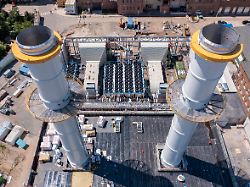Strategy after months of strife
Government agrees on hydrogen-capable gas power plants
February 5, 2024, 11:32 a.m
Listen to article
This audio version was artificially generated. More info | Send feedback
The power plant strategy has also long been a bone of contention at the traffic lights. New gas power plants that are intended to cover “dark lulls” are now receiving funding. They are expected to switch completely to hydrogen in the 2030s.
After a long struggle, the federal government has agreed on a strategy for building hydrogen-capable gas power plants in Germany. Federal Chancellor Olaf Scholz, Economics Minister Robert Habeck and Finance Minister Christian Lindner have agreed on the essential elements of a power plant strategy, according to a joint statement. Accordingly, the power plant strategy is intended to create the framework for investments in modern, highly flexible and climate-friendly power plants that will be able to be operated with hydrogen in the future.
In the short term, new power plant capacities of up to four times 2.5 gigawatts of hydrogen-capable gas power plants are to be put out to tender. From a switchover date to be set in 2032, they should then switch completely to hydrogen “between 2035 and 2040”. The funding is to be financed from the Climate and Transformation Fund, a special federal fund. According to coalition circles, the costs are around 16 billion euros for the next 20 years.
According to the communication, it was agreed that concepts for a so-called capacity mechanism should be developed. A political agreement on this should be reached within the federal government by summer 2024 at the latest. In a few years, operators could be rewarded for maintaining power plant capacity using such a mechanism.
80 percent of electricity from renewables by 2030
It was also said that the planning and approval procedures for the power plants included in the power plant strategy should be substantially accelerated. The agreement reached on the power plant strategy will be discussed with the EU Commission in Brussels. This was preceded by long negotiations within the federal government, especially between Scholz, Habeck and Lindner.
The energy industry has been waiting for a long time for a strategy to build hydrogen-capable gas power plants by 2030. Renewable plants should be massively expanded by then. The federal government’s goal is: 80 percent of electricity should come from renewable energy sources by 2030. Currently it is just over half.
Energy suppliers have so far been reluctant to invest
The new gas power plants are intended to step in during “dark periods” – when there is no wind and no sun shining – to cover electricity demand. However, energy companies have so far been reluctant to invest because the new power plants are not profitable. Habeck had spoken out in favor of state funding that could amount to billions. FDP politicians had pointed out the high costs of funding and called for “technological openness”.
The traffic light coalition had agreed to “ideally” bring forward the coal phase-out to 2030 in order to prevent the emission of climate-damaging carbon dioxide. So far, an eight-year phase-out has only been decided in the Rhenish region. It is controversial in the areas of East Germany. New gas power plants could primarily replace coal-fired power plants. They will initially be operated with natural gas, but then increasingly with climate-friendly hydrogen.
